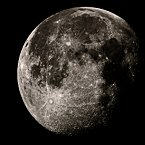Attached in this blog post is one photo of three of my captured images of the moon back in June and July 2012. Nornally, here in the USA, if you hear someone say "Shooting the moon" they are talking about someone (usually men) lowering their pants below their buttocks and fully exposing their bare butt cheeks to any onlookers. It doesn't happen so often. Usually in friendly company. I think it is considered a much more polite version of showing the onlookers the middle finger salute. In no way am I talking about THAT KIND of shooting the moon. I'm talking about capturing photos of the moon. In this case, it was with my 5.5 inch telescope that I can mount one of my cameras to it in order to get a good up-close photograph. **Same Moon Different Phases to View** In the three examples of the moon shown is a full moon (where 100% of the side that ALWAYS faces the Earth is shown), a moon with roughly 75% showing (two days later), and a moon slice with about 3% of the moon showing just a day before a new moon. *Full Moon* We all love a full moon. Considereed very romantic to see and dream about with a loved one nearby. If a full moon is rising or setting, it is especially dramatic as it seems to be larger in the sky than normal (when it really isn't) enhancxing the drama of it even more. Yet, what do we see? What do we learn? We can see it is large and that it is lit up very well. We also see the seas (large darker lowlands of the moon with rich iron content ... taken from the latin "maria"). We see very bright points of light that I call the "necklace" of the moon (in the area near what we'd normally call the tropics around the equator). The necklace are sizeable craters that are position perfectly to refelect sunlight directly back to the Earth (like parabolic mirrors). At the time of the full moon, the Sun is directly on the other side of the Earth from the moon being in front.. and the sunlight illuminates the whole disc of the moon. We can also see a couple of the larger craters on the lower portion. The largest being Tycho. We might be able to see a mountain range across the norther part if we look hard enough. But, that's about it. With full illumination, you really can not see much more. *16-Day Moon* The next (almost full moon) was taken two days after a full moon. In this case, the sun's position to the moon (as seen from the Earth is amost 26 degrees past the full moon showing about 25% less of the moon. As we look at it, this is the first photo after a full moon that the sunlight starts to scrape across the surface revealing all of the fine detail of the moon. The craters and mountains that were barely visible to us on the night of the full moon is easily seen just two days later. All of a sudden, we can see hundreds of craters and the details of the mountains as now there are shadows cast upon our nearest heavenly neighbor to give it visible texture. For this reason, I like this daily view of the moon best. It tells me a lot more information. *27 Day Moon* The 27 day moon is the last moon you can see before you have a full day before there is no moon to be seen. The moon's orbit is 28+ days long. On the first day, you have a new moon where both Moon and Sun are on the same side of the Earth. In this instance, the moon is in the sky trying to catch up to the place of orbit where it and the sun occupy the same place. This is why, during a new moon, you can not see the moon as the sun is so close on the same side somewhere nearby. However, in this case, on day 27 .. enough of the side of the moon (as we view it) is still capturing some of the rays of sunlight and reflecting it back to the Earth. The reason why this sliver of a 27-day moon has slight shade of red is because it was taken in the final light of a sunset that occure about 30-40 minutes prior. In this particular photo, I had to rush from a steakhouse in East Central Illinois, pull my telescope and it's tripod from my car, set it up in the parking lot and get it mounted, then put one of my cameras on it. I had to readjust the smaller sighting scope (with my telescope fully broken down) so that I could aim the telescope properly... of which I think I managed to finally sight it in the telescope and manage to get about 6-8 shots of it before it dipped below the apartment buildings near the steakhouse before it went below the horizon. It really was a race against time. What do we learn about the moon in this phase? Other than it's relative position to the sun as it is chasing the sun while it is setting, not a lot is learned. Therre might be a couple of craters you see that was not visible from trom the full mooon or the other. Yet, there is more than 97% of the moon's disc that is completely hidden from view. It is safe to say from this view, you know there is a moon and know it is up there. That is probably it. **What Did We Learn?** If you want to learn something, it is very important to make sure you are viewing it the way you can learn the most. Looking at people on a dating site is a lot like looking at the moon trying to learn things. If you see profile that you only skim over and don't learn anything other than to send a message that you wrote without any heart, it is like viewing a 27-day moon. If you only like what you initially see ... a tiny sliver. To those that look to the outward appearance in it's full blaring glory, youi're probably hung up on appearance much like shallow men chase after the young women with large breasts. To them, it's flashy and attractive. To them, they are being satisified by a reptile mind that evolutionarily seeks a good vessel to successfully carry on the species. And then there are those that cherish what they see in a 16-day moon. They see the thousands of tiny crevasses, cracks, shadows, moutains, valleys, and craters. They learn much from it and will settle for nothing else. They are not going through the motions nor are attractecd by what they see solely on the outside. They want and seek more. Which are you?
Quick Search

Prices & Services
Letters from 2$
Fast Gift Delivery
2-way Video Chat
5 Membership Levels
View all rates
